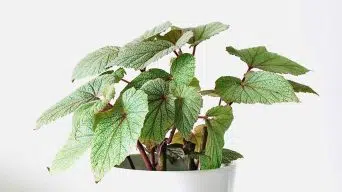Overwatering Begonias cause yellowing leaves, leaf dropping, stem breaking, and brown leaf tips. To save an overwatered Begonia, inspect and trim the root system and repot in fresh soil. Prevent overwatering by ensuring good soil drainage.
Overwatered Begonia plants can be a gardener’s nightmare, but fear not!
In this step-by-step guide, we’ll walk you through the process of identifying and saving your precious Begonia from the detrimental effects of too much water.
From assessing the damage to offering helpful tips for preventing overwatering in the future, this article is a must-read for every plant owner who wants to keep their lovely foliage happy and healthy.
Identifying Overwatering In Begonias
To ensure the health of your Begonias, it is important to identify signs of overwatering.
Yellowing leaves, brown spots, wilting foliage, moldy soil, and root rot indicate excessive watering.
By recognizing these symptoms, you can adjust your watering habits and prevent further plant damage.
Yellowing Leaves
Yellowing leaves are often the first noticeable sign of an overwatered Begonia, signaling that your plant receives too much moisture.
Overwatering deprives the roots of the vital oxygen they need to thrive and can quickly lead to other health issues for your beloved houseplant.
If you notice a sudden onset of yellowing in your Begonia leaves, don’t panic. Instead, examine both the plant and its environment to identify potential causes.
For example, has a recent temperature or humidity change occurred?
Have you recently repotted your plant into new soil?
Keep a close eye on these factors as they may contribute to improper watering practices, ultimately leading to overwatered conditions for your Begonia.
Brown Spots On The Leaves
Brown spots on the leaves of your Begonia can serve as a warning sign of overwatering, along with other potential causes.
These unsightly blemishes may develop due to excess light, temperature stress, pest infestations, and diseases.
Another common cause behind these discolored areas is a fungal infection such as powdery mildew – which often appears as small white spots before spreading across the foliage.
To help determine if overwatering is the problem, closely examine your plant for additional symptoms like moldy soil or wilting stems.
Wilting Foliage
Wilting foliage is a telltale sign of an overwatered Begonias, and addressing this issue promptly is essential.
Excess water in the soil can lead to oxygen deprivation for the plant’s roots, causing them to suffocate and eventually die.
For example, imagine you have an Angel Wing Begonia that usually boasts vibrant green leaves but starts to show signs of wilting.
At first glance, one might assume that the plant needs more water; however, this is often not the case with Begonias.
Overwatering could be the culprit behind your plant’s decline in health.
Moldy Soil
One of the telltale signs of overwatering in Begonias is moldy soil.
This can occur when excess moisture encourages the growth of fungi and bacteria in the soil.
To address this issue, removing any affected plants from their pot and disposing of the contaminated soil is important.
Wear gloves and use a clean container for your new potting mix.
Adding perlite, vermiculite, or sand to your new potting mix will increase drainage and promote healthier root growth.
Root Rot
Root rot is a common problem when overwatering leads to waterlogged soil.
This excess moisture causes the roots to decay, which affects the plant’s ability to absorb nutrients and water.
Signs of root rot on Begonias can include:
- Brown or black mushy roots.
- Wilting foliage.
- Yellowing leaves.
- Leaves falling off easily.
Assessing The Damage
If you have overwatered your Begonia, it is essential to assess the damage to prevent further harm to the plant.
This can be done by checking for root rot, evaluating the soil quality, and examining the plant’s health by inspecting its leaves and stems for signs of damage.
Checking For Root Rot
To determine the extent of damage caused by overwatering, it’s important to inspect the root system.
Ideally, your Begonia should have firm and white roots.
However, if the roots are mushy, soft, or brown/black, it indicates root rot.
In such cases, you must remove all rotten or dead roots and any affected leaves and stems using a pair of sterilized scissors or pruning shears.
Inspecting The Soil
To assess the damage caused by overwatering, inspecting the soil is crucial.
Begonias require well-draining soil to prevent water from pooling around their roots and causing root rot.
When inspecting the soil, look for signs of mold or a sour smell, which could indicate excess moisture buildup in the potting mix.
It’s also important to note that not all Begonias have identical water requirements; some prefer moist soil, while others need their soil to dry out between watering sessions.
Therefore, understanding your plant’s watering needs can prevent overwatering and save your Begonia from undue stress due to waterlogged roots.
Evaluating The Plant’s Health
Before taking any corrective measures, properly evaluating your Begonia plant’s health is crucial.
Evaluate your plant’s overall condition by looking at its foliage.
Yellowing leaves with brown spots and wilting foliage indicate excessive watering stress.
By performing these evaluations before proceeding with corrective measures like repotting or pruning, you can better understand how severe the damage is and decide on an appropriate course of action to save your begonia plant.
Steps To Save An Overwatered Begonia
If you’ve overwatered your begonia plant, don’t panic!
There are simple steps you can take to save it.
By following the proper techniques, you can help your Begonia recover and thrive once again.
1. Stop Watering Immediately
Overwatering is a common mistake when it comes to growing begonias. It can lead to root rot and other issues.
If you suspect your Begonia has been overwatered, the first step in saving it is to stop watering immediately.
Here’s how to do it:
- Take the plant from its pot and place it on a clean surface.
- Carefully remove excess water from the soil using paper towels or a clean cloth.
- Check the drainage holes at the bottom of the pot to make sure they’re not clogged.
- If there’s still standing water in the soil, use a fork or chopstick to poke several holes in the soil’s surface to allow for better drainage.
- Move the Begonia to a location with good airflow but no direct sunlight.
2. Remove The Plant From The Pot
To save an overwatered Begonia, removing the plant from its pot is crucial.
This step allows you to assess the root system and check for signs of rot or damage caused by excess watering.
Gently loosen the soil around the roots and carefully lift out the plant.
Once removed from its pot, inspect the root system closely.
Root rot is a common problem in overwatered plants, so look for mushy, soft brown, or black roots.
3. Trim Rotten Or Dead Roots And Stems
To save your Begonia, one of the essential steps is to trim any rotten or dead roots and stems.
Here’s how to do it:
- Gently remove the plant from the soil and inspect the roots and stem.
- Use clean, sharp scissors or pruning shears to cut away any black or mushy roots.
- Trim any soft or discolored sections on the stem until you reach healthy tissue.
- If there are no healthy roots left, you may need to cut off the top of the plant and use it as a cutting to propagate a new Begonia.
- Dispose of any diseased plant material in sealed plastic bags or containers to prevent the spread of disease.
Trimming away damaged roots helps prevent further decay and encourages new root growth.
However, be careful not to remove too much healthy tissue, which can stress an already weakened plant.
4. Repot The Begonia In Fresh Soil
After trimming the rotten or dead roots and stems, it’s time to repot your Begonia in fresh soil.
- Choose a pot one size larger than the previous one with good drainage holes at the bottom.
- Gently fill around the plant’s root ball with more soil until it reaches 1 inch below the top rim of the pot.
- Pat down lightly and water generously until you see excess water from the drainage holes.
Remember to choose a well-draining mix for indoor plants like perlite, bark bits, peat moss, or vermiculite mixed in equal proportions with regular soil mix to help prevent overwatering and improve overall drainage.
5. Monitor And Adjust Care
After saving your overwatered Begonia, monitoring and adjusting care is important to prevent the plant from experiencing the same issue again.
Here are some tips:
- Monitor soil moisture: Check the soil regularly by sticking your finger about an inch into the soil. If it feels dry, it’s time to water. If it still feels moist, wait a few more days before checking again.
- Adjust watering frequency: Depending on the environmental conditions of your home or office, you may need to adjust how often you water your Begonia. For example, if you live in a humid climate, you may need to water less frequently than in a drier weather.
- Improve drainage: Make sure your Begonia has proper drainage by using pots with drainage holes and adding pebbles or rocks at the bottom of the pot.
- Provide adequate lighting: Begonias prefer bright indirect light or partial shade, so ensure they’re not exposed to direct sunlight for extended periods.
- Fertilize appropriately: Use a liquid fertilizer explicitly formulated for begonias every 2-4 weeks during their growing season (spring and summer).
Tips For Preventing Overwatering Begonia Plants
Preventing overwatering is crucial for the health and longevity of Begonia plants.
Here are some tips for preventing overwatering to help you keep your Begonia plants thriving.
1. Use Well-Draining Soil
When planting your begonias, it is crucial to use well-draining soil to prevent overwatering and root rot.
Here are some tips on how to ensure proper drainage for your begonia plants:
- Choose a pot with a drainage hole: Make sure the container has a drainage hole at the bottom, allowing excess water to escape.
- Add peat moss or perlite to the soil mix: These materials help loosen the soil and aid in drainage.
- Avoid heavy soils: Soil mixes that are too heavy, such as clay-based mixes, retain water and can lead to overwatering.
- Use high-quality potting mix: It’s essential to use a good quality potting mix designed for indoor plants with good drainage properties.
- Consider adding sand or vermiculite: Mixing sand or vermiculite into your potting mix can help improve drainage even further.
2. Water In The Morning
To prevent overwatering your Begonia plants, it’s important to water them in the morning.
This allows excess moisture to evaporate throughout the day and helps avoid creating an environment that encourages fungal growth.
One common mistake when watering is giving your plant a quick drink before leaving for work or at night after dinner.
This can lead to water sitting in the pot and not adequately absorbed by the soil, leading to root rot and other issues.
3. Allow The Top Inch Of Soil To Dry Before Watering
One effective way to prevent overwatering in your begonia plants is by allowing the top inch of soil to dry before watering.
Here are some tips for implementing this technique:
- Use your fingers or a moisture meter to check the soil’s moisture level.
- Water the plant thoroughly when the top inch of the soil feels dry.
- Avoid watering on a schedule – instead, let the plant’s needs and environment dictate when it requires moisture.
- If you’re unsure whether your plant needs water, wait and recheck the soil’s moisture level later in the day or the next.
- Remember that other factors, such as temperature, humidity, and sunlight exposure, can affect how quickly your soil dries out.
Keeping track of the days you water your plants and monitoring their soil regularly can also help maintain their health and prevent overwatering.
4. Adjust Watering Based On The Weather
It’s essential to adjust your watering routine for your begonia plant based on the weather.
During hot and dry seasons, you may need to water more frequently than during cooler months.
Similarly, if it often rains in your area, you can cut back on watering altogether.
One way to monitor this is by checking the soil moisture regularly – if it feels dry up to an inch beneath the surface, it’s time to water again.
However, avoid overwatering as this can lead to root rot and other issues discussed earlier in the article.
For example, during summer months, when temperatures are high and humidity is low, you might need to increase the frequency of watering since the evaporation rate is higher compared with winter or fall seasons when plants don’t require much watering due to less heat or sun exposure that causes them not too thirsty as much.
Final Thoughts
Saving your overwatered Begonia can seem daunting, but with the proper steps and care, bringing it back to health is possible.
Remember to stop watering immediately, trim away damaged roots and stems, and repot in fresh soil with proper drainage.
It is also vital to monitor and adjust care as needed while preventing overwatering in the future by using well-draining soil and adjusting watering based on weather conditions.
By following these tips and steps, you can enjoy the beauty of your Begonia for years to come.







